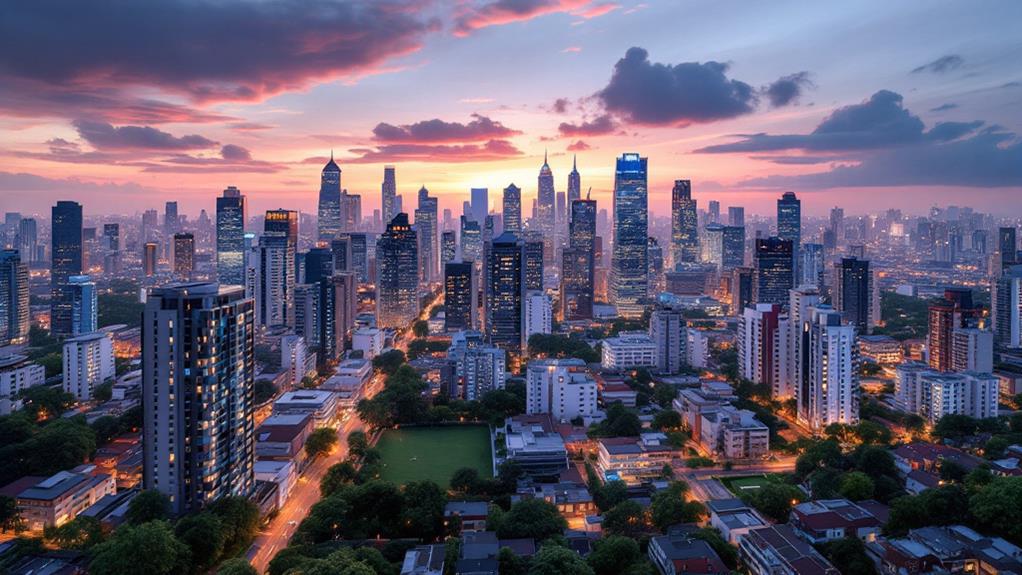How the Largest Urban Areas in the World Manage Housing and Real Estate

In the world's largest urban areas, you see dynamic strategies at play to manage housing and real estate. Zoning reforms and mixed-use developments optimize limited land, offering varied living options. Cities prioritize affordable housing as soaring property values challenge many, creating 'generation rent' scenarios. Advances like VR, 3D printing, and smart home tech revolutionize construction and buying processes, while digital platforms improve market navigation. Sustainable practices, using eco-friendly materials and energy-efficient designs, are vital as cities address over 70% of greenhouse gas emissions. Understanding demographic shifts is key to adapting housing strategies. There's much more to uncover about global urban management.
Urbanization and Housing Policies
Urbanization is reshaping the landscape of housing policies worldwide. With over 55% of the global population already residing in cities and projections indicating a rise to 68% by 2050, urbanization places immense pressure on housing policies. As cities grow, so does the need for affordable housing, making it essential for urban development to incorporate inclusive solutions. The challenge is evident in major cities like San Francisco and New York, where soaring property values highlight the urgent need for creative housing policies.
To address this, cities must adopt zoning reforms and encourage mixed-use developments. These strategies optimize land use and provide diverse housing options, aiming for a more sustainable urban environment. Effective housing policies, like those in Singapore and Copenhagen, integrate affordable housing within urban development plans. This approach guarantees inclusivity, accommodating the needs of a rapidly increasing urban population.
With the global residential real estate market projected to reach $1 trillion by 2030, the necessity for sustainable and resilient housing policies becomes even more pressing. As population growth continues, you must focus on creating housing solutions that are not only affordable but also adaptable to future demands, guaranteeing a balanced urban environment.
Balancing Affordability and Demand
As cities expand at unprecedented rates, managing the balance between affordability and demand becomes vital. Rapid urbanization has created a massive demand for housing, with urban populations projected to surpass 7 billion by 2050. This intensifies the need for affordable housing solutions in the real estate market. In cities like San Francisco, soaring property values outstrip income growth, leading to a "generation rent" scenario. This highlights the challenge urban areas face in ensuring economic growth without sidelining affordability.
To tackle this, midsize cities such as Nashville and Melbourne are gaining traction. They offer more affordable living options, attracting migration from rural areas and easing demand pressures in larger urban centers. These cities demonstrate that effective zoning and development trends can promote both talent attraction and inclusive growth.
Sustainable urban development policies that focus on inclusivity and affordable housing are critical. Limited land availability and rising construction costs exacerbate the supply-demand imbalance. To counter this, cities must implement strategies that prioritize affordable housing, ensuring that urbanization leads to equitable growth. By addressing these issues, urban areas can create a balanced real estate market that supports sustainable economic growth and meets the needs of expanding urban populations.
Technological Innovations in Real Estate

In the current fast-paced real estate market, technological innovations like virtual reality (VR) and 3D printing are transforming how properties are visualized and constructed. VR allows you to experience homes before they're built, offering engaging property visualization that helps in decision-making. 3D printing streamlines construction, enhancing efficiency and cutting costs considerably.
Smart home technologies are elevating property appeal in urban areas. Energy-efficient appliances and advanced security systems not only improve convenience but also attract tech-savvy buyers, ultimately raising property value. As consumer preferences shift towards more connected living spaces, these features are becoming vital in real estate development.
Digital platforms simplify the buying and selling process, making market navigation more straightforward. These platforms connect buyers and sellers seamlessly, allowing real estate agents to manage listings with greater effectiveness. In urban areas, the use of software solutions for property management is transforming operational processes. Improved tenant communication, efficient maintenance tracking, and better financial management are now within reach for both residential and commercial properties.
Lastly, big data and analytics play an important role in understanding market trends and consumer preferences, aiding informed decision-making in real estate development and investment strategies.
Sustainable Urban Development Practices
Sustainability in urban development is more fundamental than ever as cities endeavor to balance economic growth with environmental stewardship. You're witnessing cities accounting for over 70% of global greenhouse gas emissions, and it's imperative for urban planning to integrate sustainable practices. By incorporating eco-friendly building materials and energy-efficient technologies, urban areas can considerably reduce their environmental impact.
Urban planners are investing in infrastructure development that improves city systems, with the World Bank contributing approximately $5 billion annually to support these urban projects. This investment aids in promoting sustainable urban development by building capacities at local levels. Green spaces are becoming a staple in urban planning, with cities like Copenhagen leading the way by prioritizing cycling and outdoor areas. These initiatives not only improve livability but also elevate environmental health.
Innovative housing solutions are also gaining traction. You're seeing a rise in tiny homes and integrated townships as affordable options for the growing urban population. These solutions foster community engagement by creating inclusive environments that cater to diverse needs. Embracing these sustainable practices is imperative for crafting urban spaces that can support future generations while minimizing resource consumption.
Addressing Demographic Shifts

Urban development's focus on sustainability naturally leads to addressing demographic shifts impacting housing needs. As urbanization trends continue, you're witnessing the urban population grow dramatically, projected to reach 68% by 2050. This surge demands adaptive housing strategies to meet diverse needs within the real estate sector. Millennials and Generation Z drive demand for urban apartments, pushing cities like New York and San Francisco to rethink their offerings. Meanwhile, families increasingly opt for suburban single-family homes, reflecting evolving lifestyle choices.
With the aging baby boomer generation, there's a significant demand for senior-friendly housing. Cities must adapt by incorporating accessible and supportive living environments into their real estate plans. The rise of remote work has further altered housing preferences, with a growing interest in homes featuring dedicated office spaces. This shift requires urban housing designs to evolve accordingly.
Fast-growing cities, such as Austin and Charlotte, exemplify the challenges of rapid population growth. They've experienced population increases of over 50% from 2000 to 2010, intensifying the need for affordable housing. As property prices rise, ensuring access to affordable housing becomes a priority, demanding creative solutions from the real estate sector.



